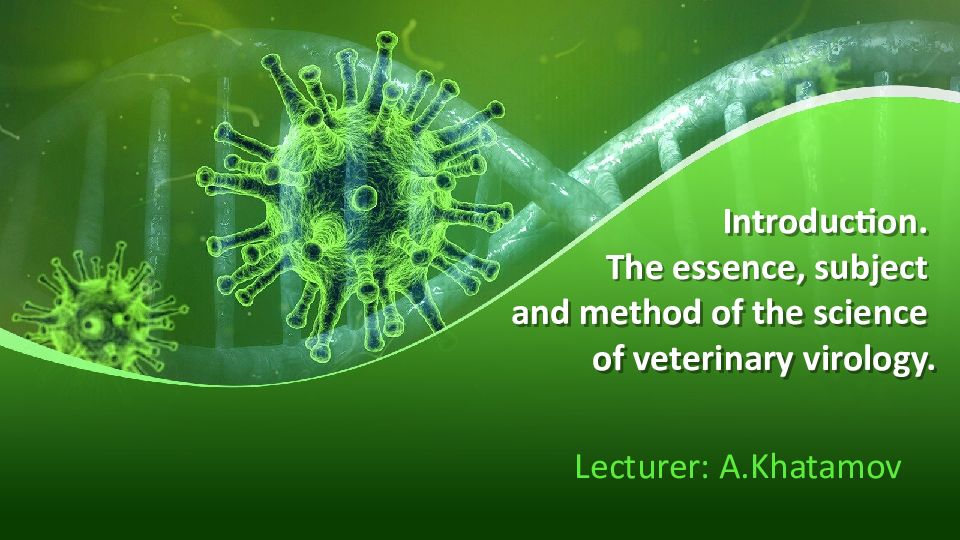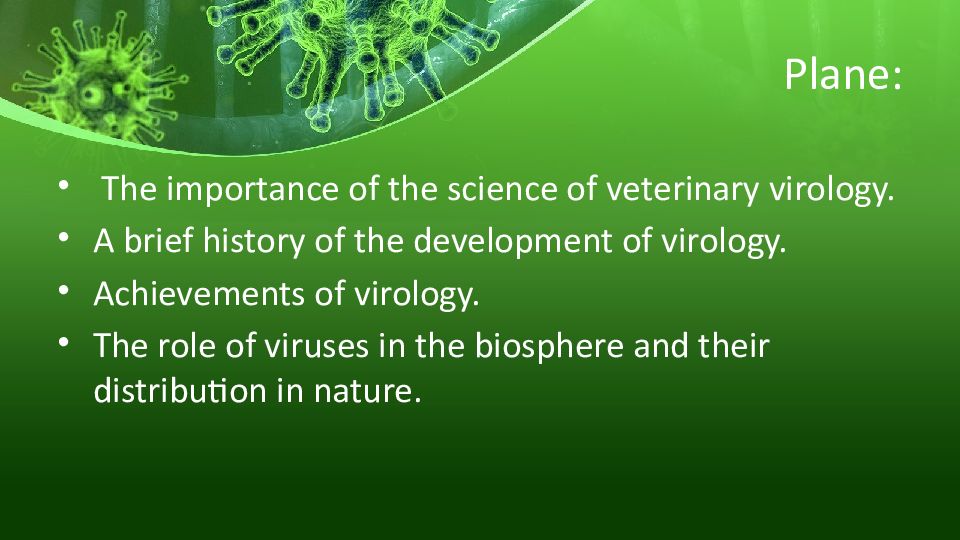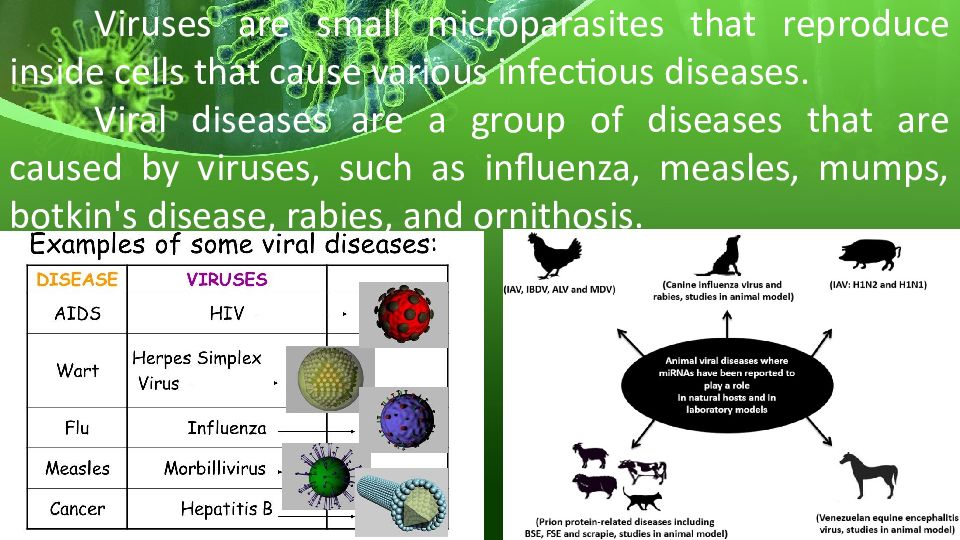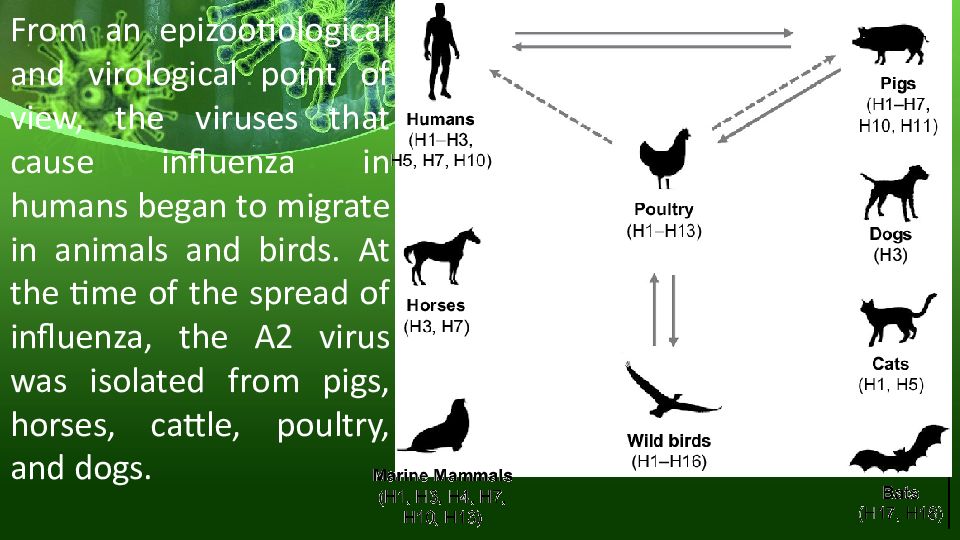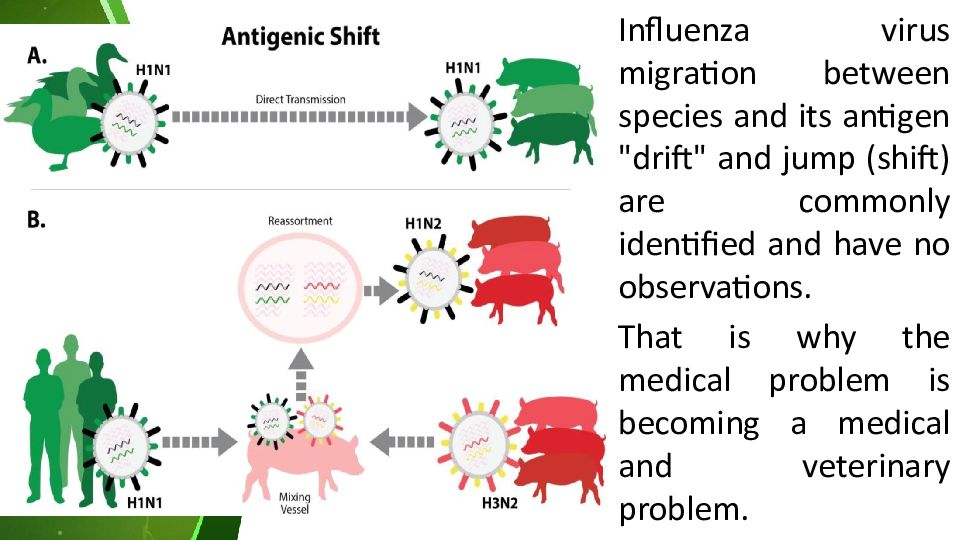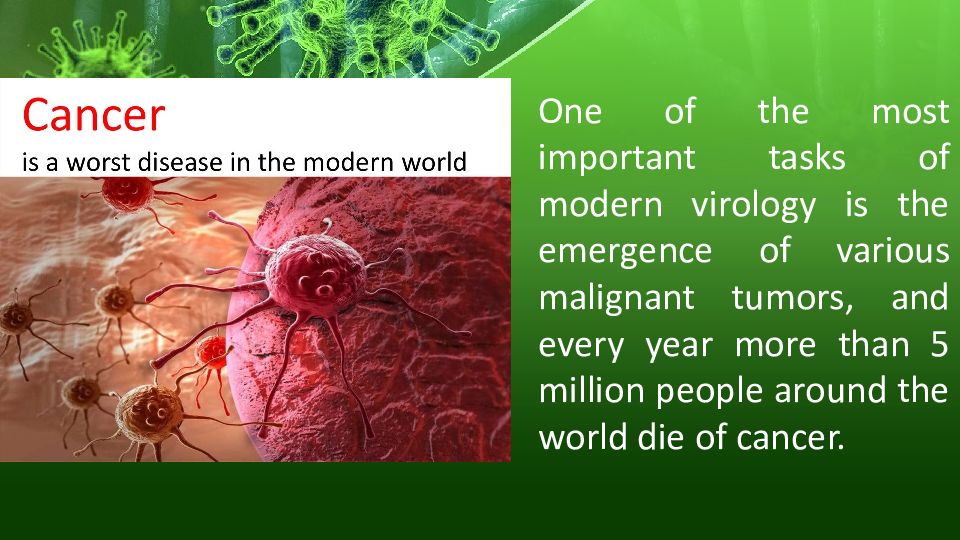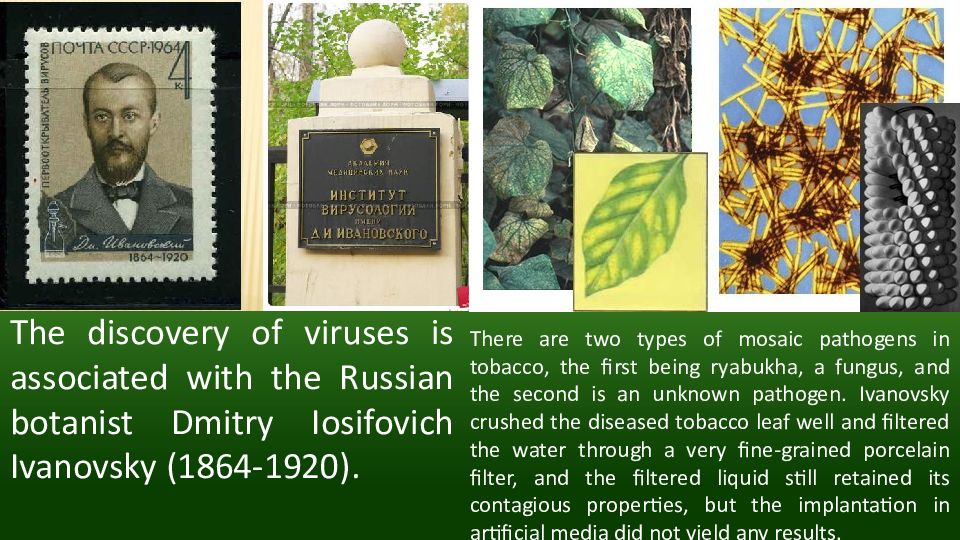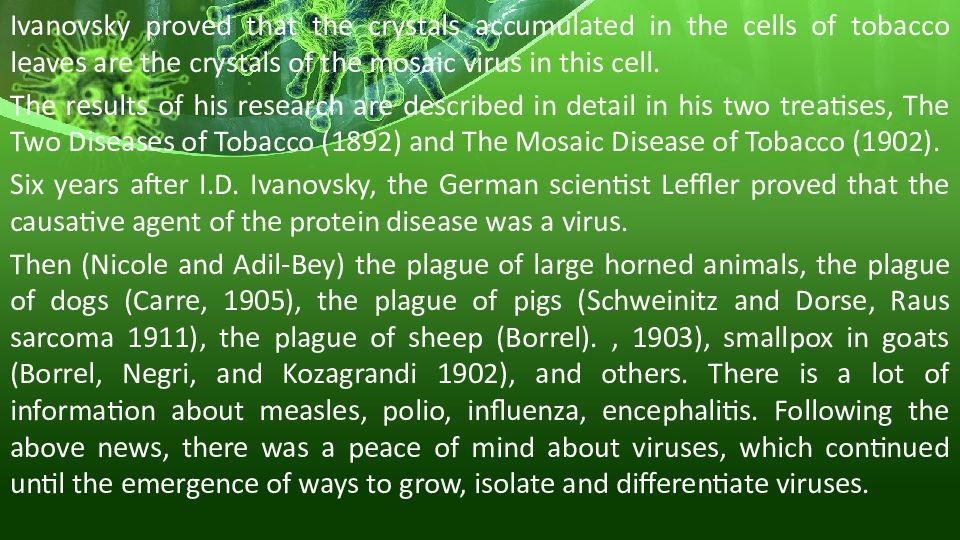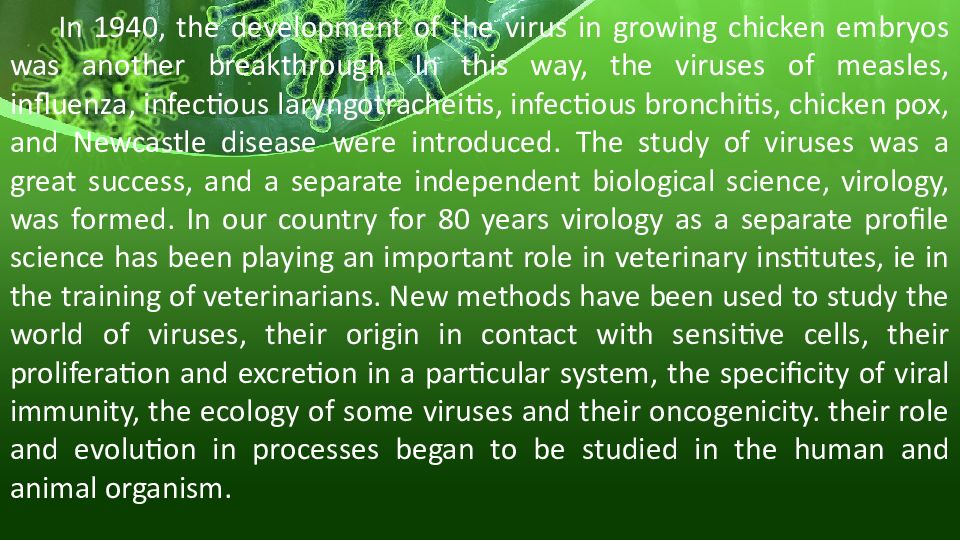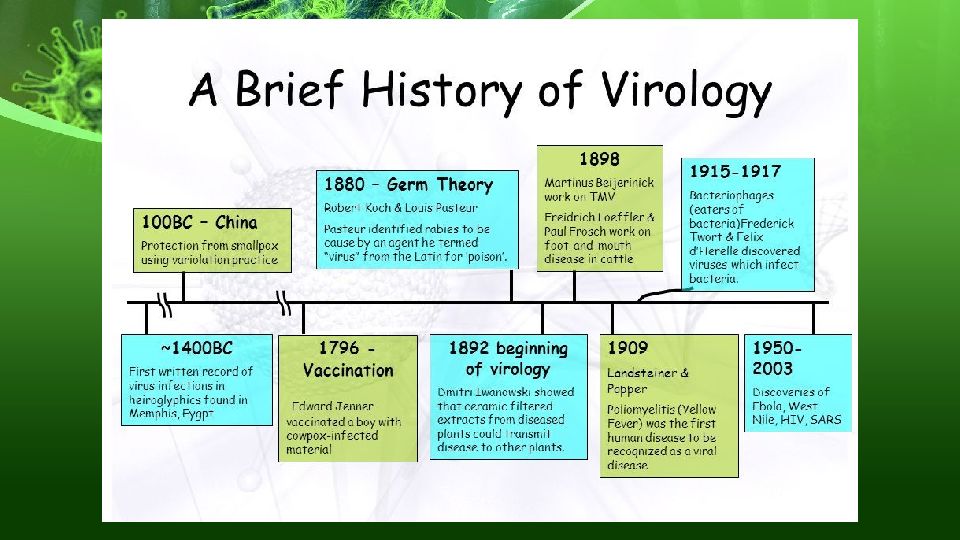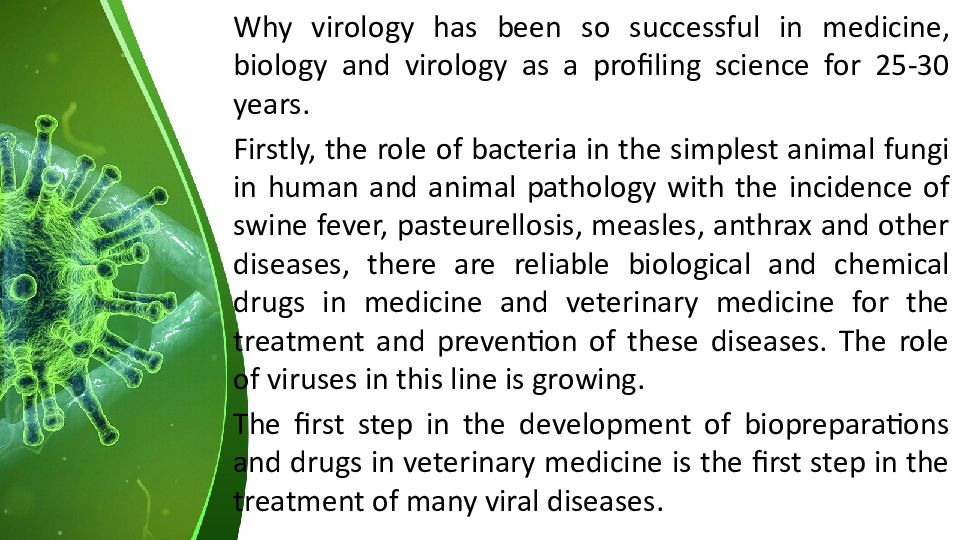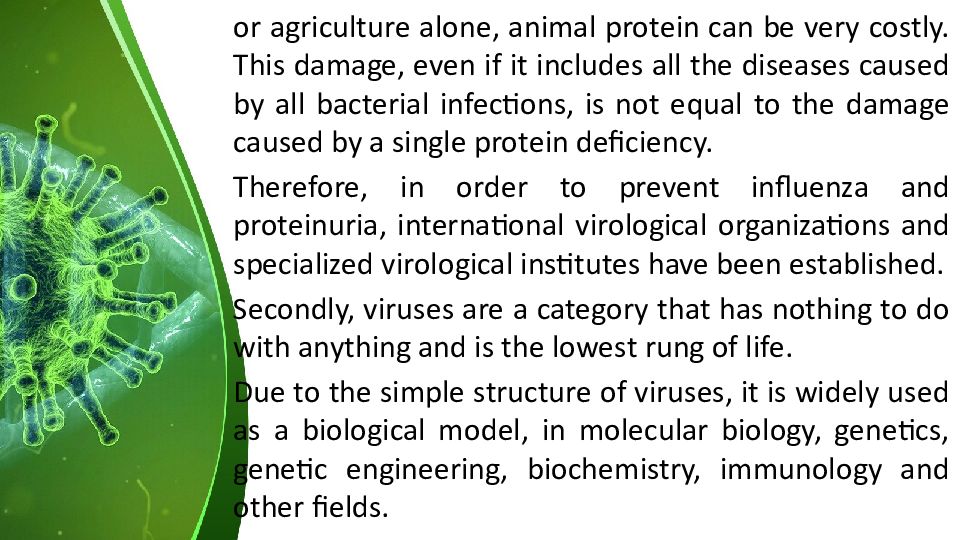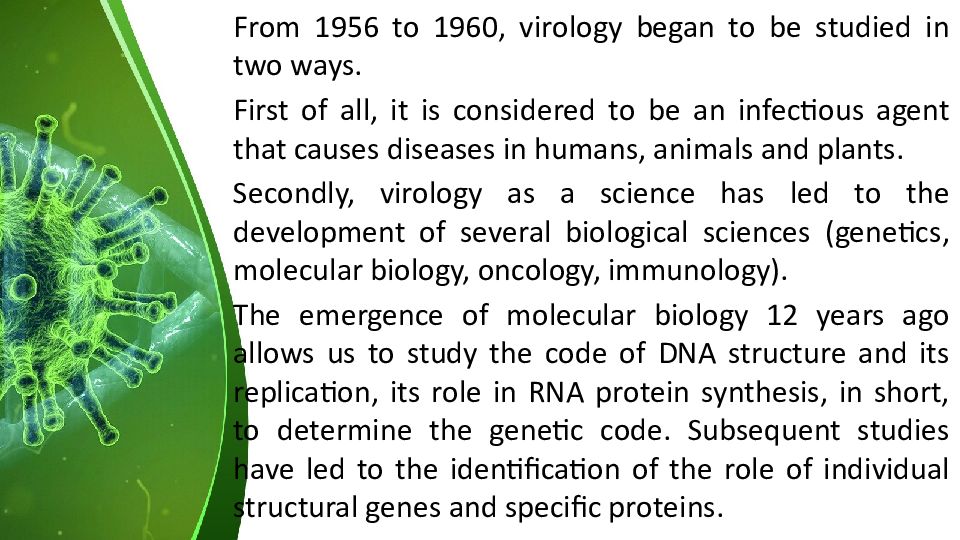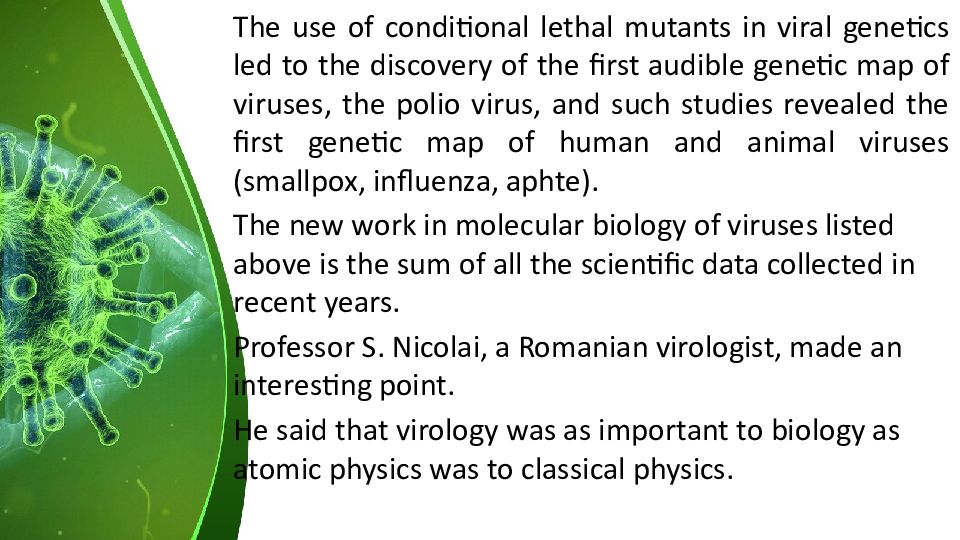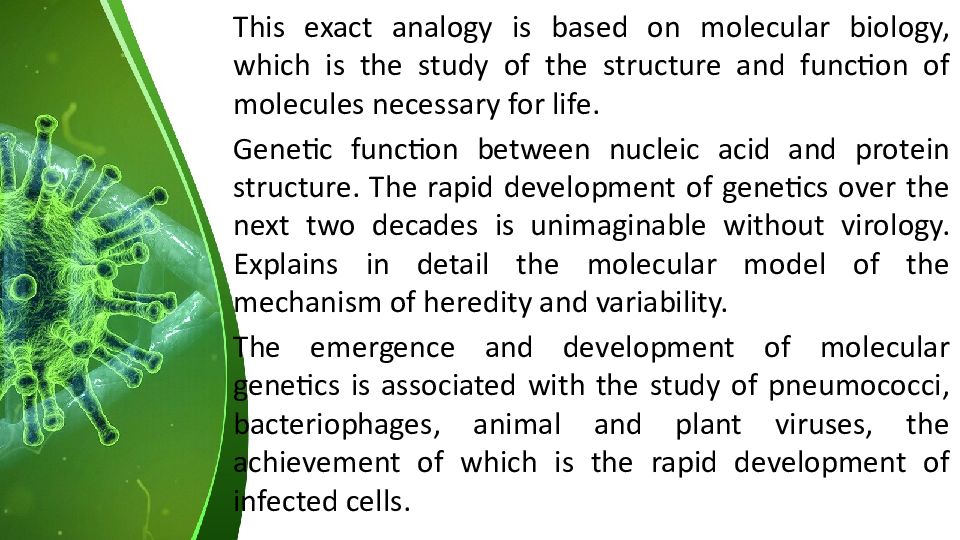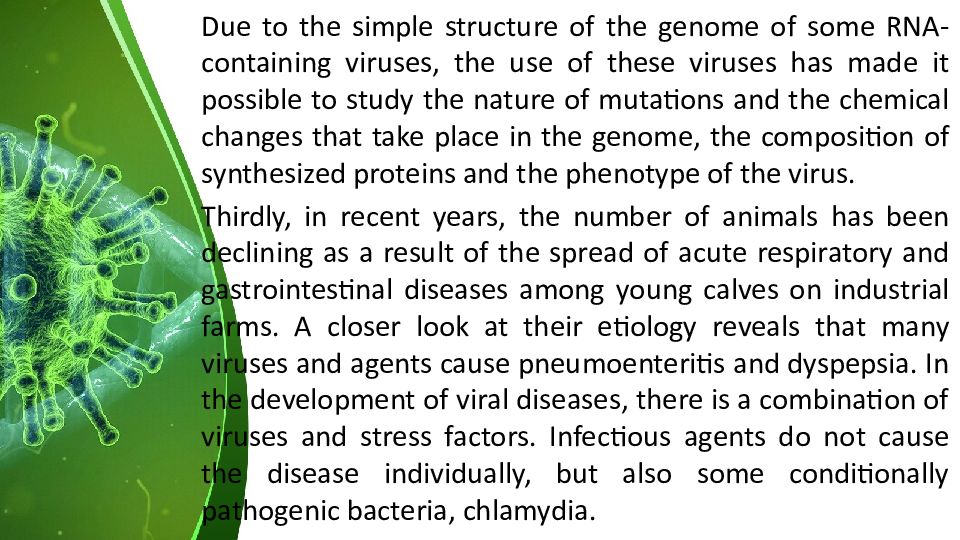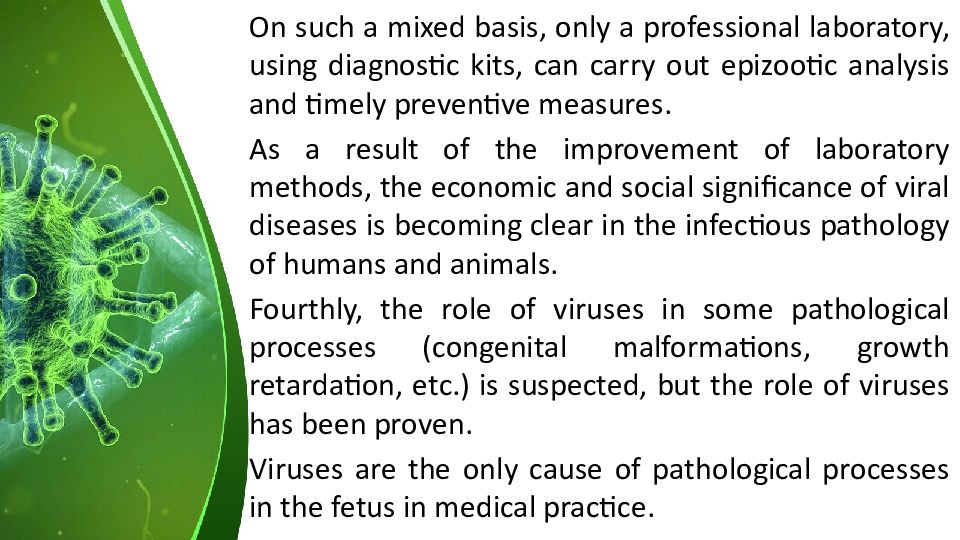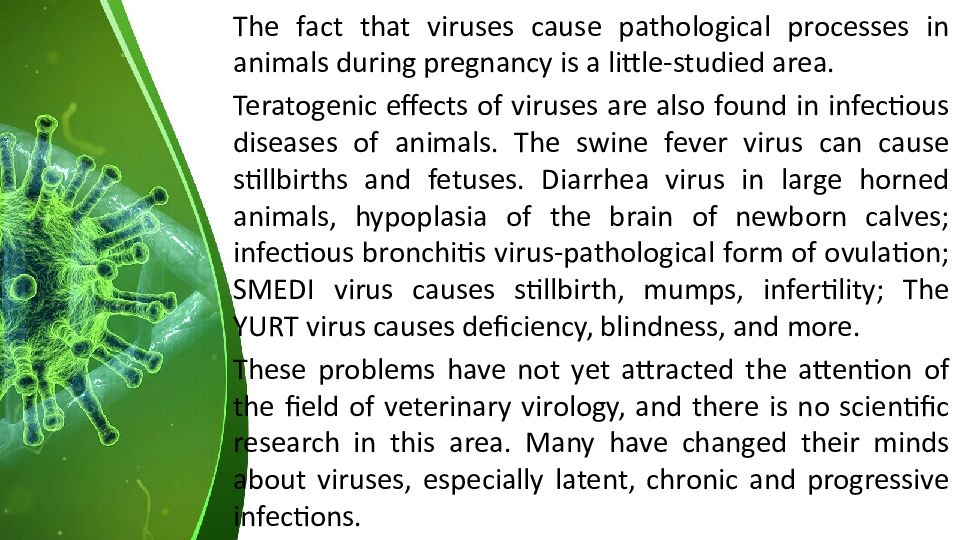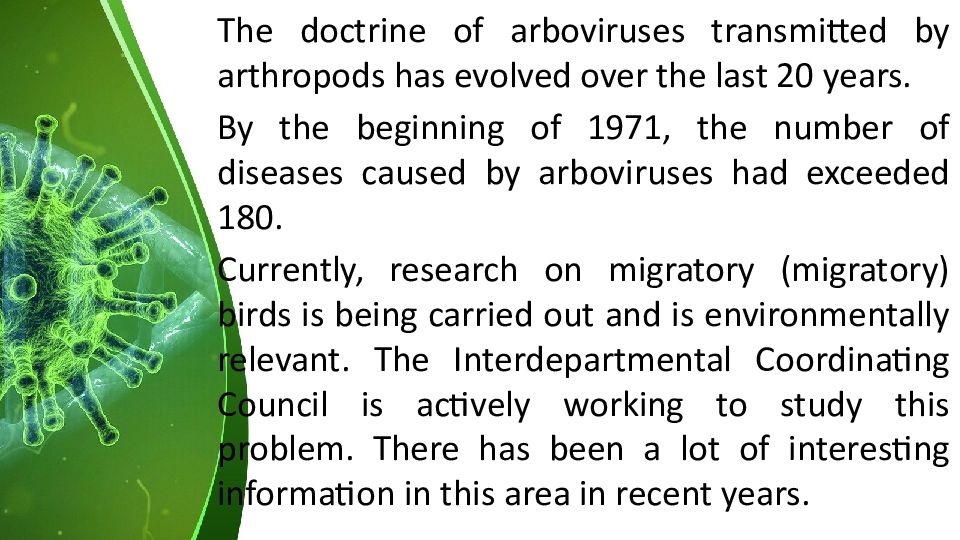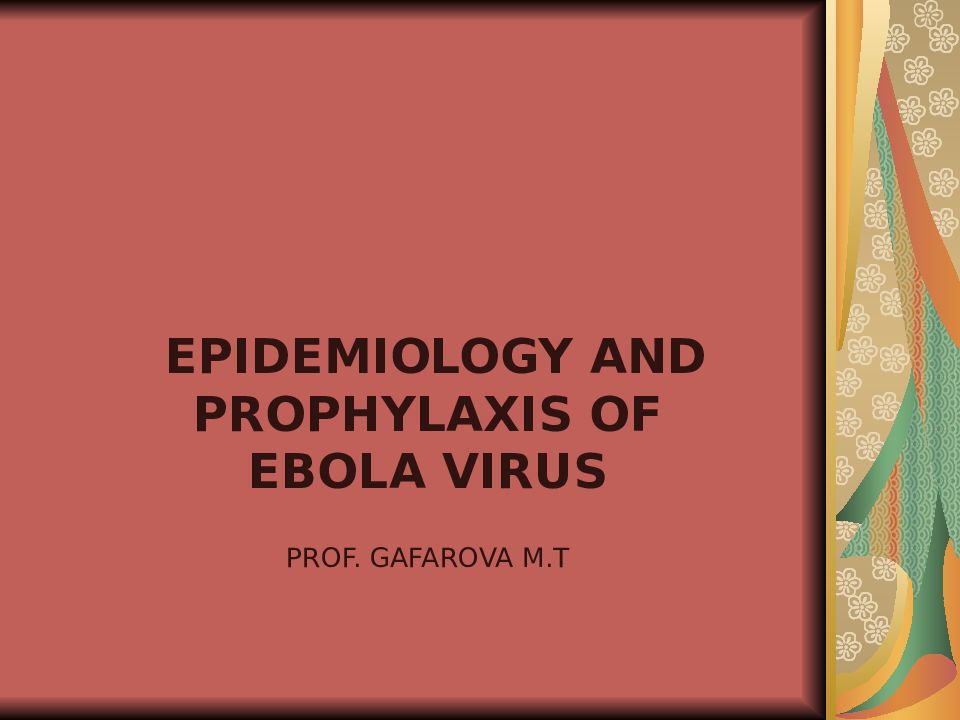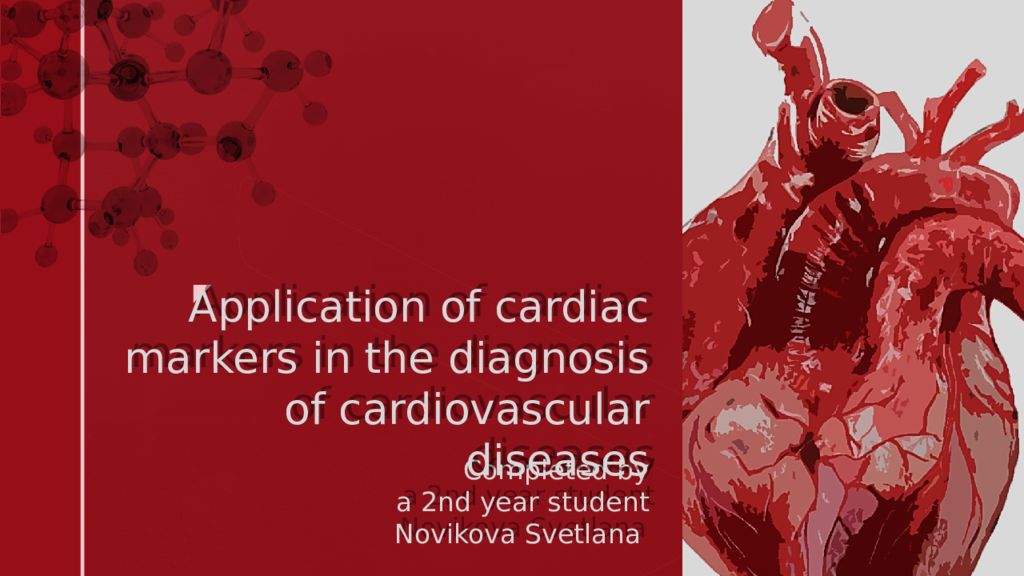Первый слайд презентации: Introduction. The essence, subject and method of the science of veterinary virology
Lecturer: A.Khatamov
Слайд 2: Plane:
The importance of the science of veterinary virology. A brief history of the development of virology. Achievements of virology. The role of viruses in the biosphere and their distribution in nature.
Слайд 3
Viruses are made up of nucleic acid, RNA, or DNA, which causes the nucleic acid to reproduce only in living cells and to synthesize the virus, the virion, from the cell. A new virus created in this way will be able to reproduce itself in the future.
Слайд 5
Viruses are small microparasites that reproduce inside cells that cause various infectious diseases. Viral diseases are a group of diseases that are caused by viruses, such as influenza, measles, mumps, botkin's disease, rabies, and ornithosis.
Слайд 6
From an epizootiological and virological point of view, the viruses that cause influenza in humans began to migrate in animals and birds. At the time of the spread of influenza, the A2 virus was isolated from pigs, horses, cattle, poultry, and dogs.
Слайд 7
Influenza virus migration between species and its antigen "drift" and jump (shift) are commonly identified and have no observations. That is why the medical problem is becoming a medical and veterinary problem.
Слайд 8
One of the most important tasks of modern virology is the emergence of various malignant tumors, and every year more than 5 million people around the world die of cancer.
Слайд 10
To date, medicine and veterinary medicine have not been able to develop biological drugs for many viral diseases, such as AIDS, avian influenza, and others. He is currently undergoing chemotherapy. For example, the damage caused by a single protein disease, including anthrax and other bacterial infections, is not the same as the damage caused by foot and mouth disease.
Слайд 11
The discovery of viruses is associated with the Russian botanist Dmitry Iosifovich Ivanovsky (1864-1920). There are two types of mosaic pathogens in tobacco, the first being ryabukha, a fungus, and the second is an unknown pathogen. Ivanovsky crushed the diseased tobacco leaf well and filtered the water through a very fine-grained porcelain filter, and the filtered liquid still retained its contagious properties, but the implantation in artificial media did not yield any results.
Слайд 12
Ivanovsky proved that the crystals accumulated in the cells of tobacco leaves are the crystals of the mosaic virus in this cell. The results of his research are described in detail in his two treatises, The Two Diseases of Tobacco (1892) and The Mosaic Disease of Tobacco (1902). Six years after I.D. Ivanovsky, the German scientist Leffler proved that the causative agent of the protein disease was a virus. Then (Nicole and Adil-Bey ) the plague of large horned animals, the plague of dogs ( Carre, 1905), the plague of pigs ( Schweinitz and Dorse, Raus sarcoma 1911), the plague of sheep ( Borrel )., 1903), smallpox in goats ( Borrel, Negri, and Kozagrandi 1902), and others. There is a lot of information about measles, polio, influenza, encephalitis. Following the above news, there was a peace of mind about viruses, which continued until the emergence of ways to grow, isolate and differentiate viruses.
Слайд 13
In 1940, the development of the virus in growing chicken embryos was another breakthrough. In this way, the viruses of measles, influenza, infectious laryngotracheitis, infectious bronchitis, chicken pox, and Newcastle disease were introduced. The study of viruses was a great success, and a separate independent biological science, virology, was formed. In our country for 80 years virology as a separate profile science has been playing an important role in veterinary institutes, ie in the training of veterinarians. New methods have been used to study the world of viruses, their origin in contact with sensitive cells, their proliferation and excretion in a particular system, the specificity of viral immunity, the ecology of some viruses and their oncogenicity. their role and evolution in processes began to be studied in the human and animal organism.
Слайд 15
Why virology has been so successful in medicine, biology and virology as a profiling science for 25-30 years. Firstly, the role of bacteria in the simplest animal fungi in human and animal pathology with the incidence of swine fever, pasteurellosis, measles, anthrax and other diseases, there are reliable biological and chemical drugs in medicine and veterinary medicine for the treatment and prevention of these diseases. The role of viruses in this line is growing. The first step in the development of biopreparations and drugs in veterinary medicine is the first step in the treatment of many viral diseases.
Слайд 16
or agriculture alone, animal protein can be very costly. This damage, even if it includes all the diseases caused by all bacterial infections, is not equal to the damage caused by a single protein deficiency. Therefore, in order to prevent influenza and proteinuria, international virological organizations and specialized virological institutes have been established. Secondly, viruses are a category that has nothing to do with anything and is the lowest rung of life. Due to the simple structure of viruses, it is widely used as a biological model, in molecular biology, genetics, genetic engineering, biochemistry, immunology and other fields.
Слайд 17
From 1956 to 1960, virology began to be studied in two ways. First of all, it is considered to be an infectious agent that causes diseases in humans, animals and plants. Secondly, virology as a science has led to the development of several biological sciences (genetics, molecular biology, oncology, immunology). The emergence of molecular biology 12 years ago allows us to study the code of DNA structure and its replication, its role in RNA protein synthesis, in short, to determine the genetic code. Subsequent studies have led to the identification of the role of individual structural genes and specific proteins.
Слайд 18
Biophysics, molecular biology, and genetics, on the other hand, deepen the understanding of the origin and nature of viruses. Recent debates have been less successful, with many respondents relying on new methods and facts from physics, chemistry, biochemistry, and electron microscopy. Therefore, in the last 6-8 years, we have before us new processes, such as the reproduction of DNA and RNA-storing viruses, the replicative form of the nucleic acid that plays a key role, and the replicative satellites. The RNA of myxoviruses has been found to be fragmentable. Specific mechanisms governing protein synthesis in some viruses include transcription and translation, synthesis of "morning" and "evening" proteins, and the order of genetic information.
Слайд 19
The use of conditional lethal mutants in viral genetics led to the discovery of the first audible genetic map of viruses, the polio virus, and such studies revealed the first genetic map of human and animal viruses (smallpox, influenza, aphte ). The new work in molecular biology of viruses listed above is the sum of all the scientific data collected in recent years. Professor S. Nicolai, a Romanian virologist, made an interesting point. He said that virology was as important to biology as atomic physics was to classical physics.
Слайд 20
This exact analogy is based on molecular biology, which is the study of the structure and function of molecules necessary for life. Genetic function between nucleic acid and protein structure. The rapid development of genetics over the next two decades is unimaginable without virology. Explains in detail the molecular model of the mechanism of heredity and variability. The emergence and development of molecular genetics is associated with the study of pneumococci, bacteriophages, animal and plant viruses, the achievement of which is the rapid development of infected cells.
Слайд 21
Due to the simple structure of the genome of some RNA-containing viruses, the use of these viruses has made it possible to study the nature of mutations and the chemical changes that take place in the genome, the composition of synthesized proteins and the phenotype of the virus. Thirdly, in recent years, the number of animals has been declining as a result of the spread of acute respiratory and gastrointestinal diseases among young calves on industrial farms. A closer look at their etiology reveals that many viruses and agents cause pneumoenteritis and dyspepsia. In the development of viral diseases, there is a combination of viruses and stress factors. Infectious agents do not cause the disease individually, but also some conditionally pathogenic bacteria, chlamydia.
Слайд 22
On such a mixed basis, only a professional laboratory, using diagnostic kits, can carry out epizootic analysis and timely preventive measures. As a result of the improvement of laboratory methods, the economic and social significance of viral diseases is becoming clear in the infectious pathology of humans and animals. Fourthly, the role of viruses in some pathological processes (congenital malformations, growth retardation, etc.) is suspected, but the role of viruses has been proven. Viruses are the only cause of pathological processes in the fetus in medical practice.
Слайд 23
The fact that viruses cause pathological processes in animals during pregnancy is a little-studied area. Teratogenic effects of viruses are also found in infectious diseases of animals. The swine fever virus can cause stillbirths and fetuses. Diarrhea virus in large horned animals, hypoplasia of the brain of newborn calves; infectious bronchitis virus-pathological form of ovulation; SMEDI virus causes stillbirth, mumps, infertility; The YURT virus causes deficiency, blindness, and more. These problems have not yet attracted the attention of the field of veterinary virology, and there is no scientific research in this area. Many have changed their minds about viruses, especially latent, chronic and progressive infections.
Последний слайд презентации: Introduction. The essence, subject and method of the science of veterinary
The doctrine of arboviruses transmitted by arthropods has evolved over the last 20 years. By the beginning of 1971, the number of diseases caused by arboviruses had exceeded 180. Currently, research on migratory (migratory) birds is being carried out and is environmentally relevant. The Interdepartmental Coordinating Council is actively working to study this problem. There has been a lot of interesting information in this area in recent years.
